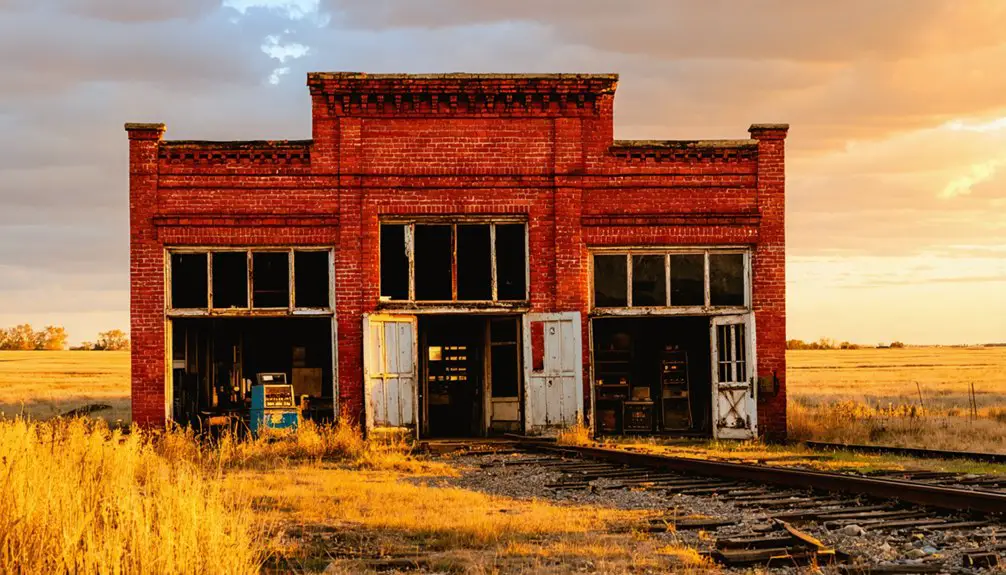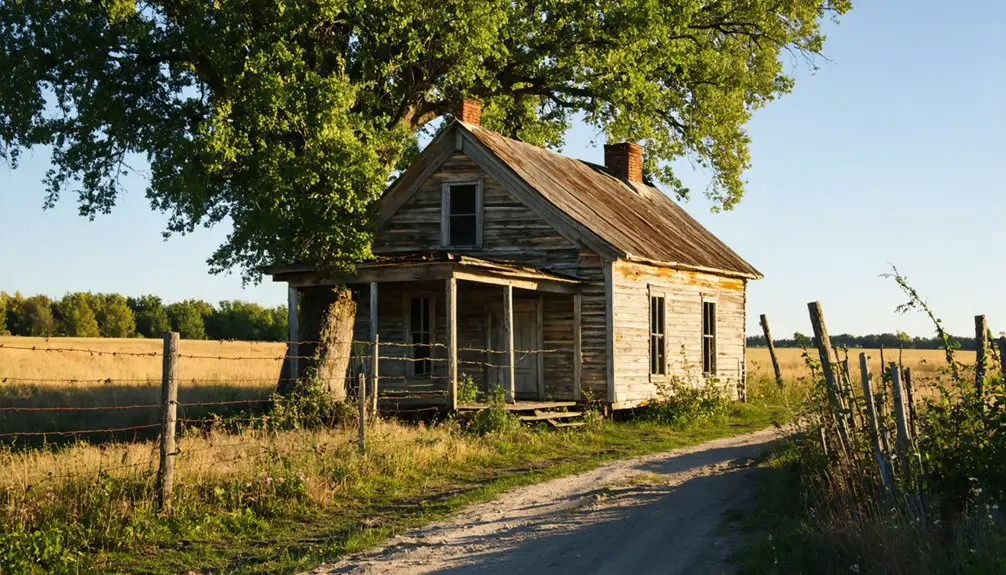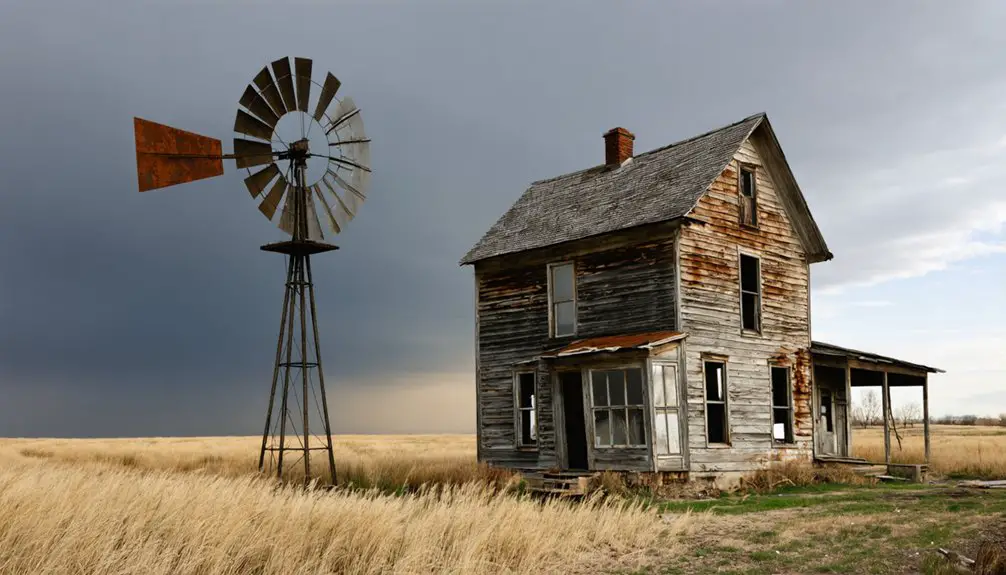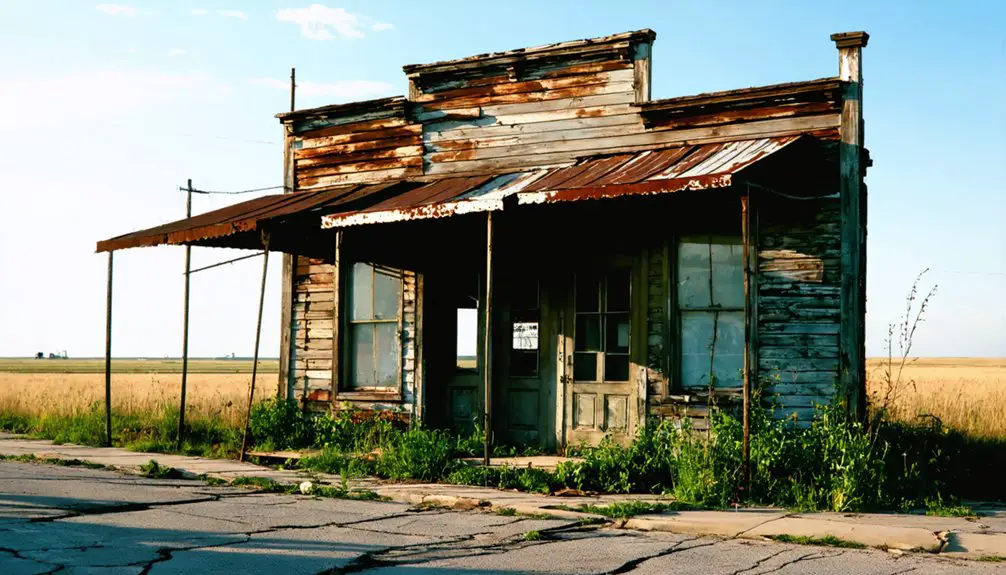You’ll find Rock Bluff’s remnants 3-4 miles east and one mile north of Murray, Nebraska, where German immigrant Benedict Spires founded this Missouri River settlement in 1854. The town flourished as a major steamboat landing and freight hub, reaching 200 residents by 1877. While railroads ultimately led to its decline in the 1890s, Rock Bluff’s preserved school building and rich history of river commerce, coal mining, and pioneer resilience offer fascinating insights into Nebraska’s territorial era.
Key Takeaways
- Rock Bluff was established in 1854 by German immigrant Benedict Spires and reached its peak population of 200 residents by 1877.
- The town served as a major steamboat landing and freight hub along the Missouri River during the 1860s.
- Railroad development in the 1870s marked the beginning of Rock Bluff’s decline as a commercial center.
- The town featured the Naomi Institute, Methodist Church, general stores, and a 50,000-bushel grain elevator during its prime.
- Today, only the Rock Bluff School remains as a museum preserving the ghost town’s local heritage.
The Birth of a River Settlement
As steamboats churned along the Missouri River in 1854, German immigrant Benedict Spires established what would become Rock Bluff, Nebraska, on the rocky banks that gave the settlement its name.
You’ll find this pioneering community’s settlement origins tied closely to river navigation, as it emerged at a strategic point approximately 3-4 miles east and one mile north of present-day Murray. The town quickly became a leading freighting outpost for settlers heading westward.
The settlement grew steadily and became an important river crossing, reaching its peak with nearly 200 residents by 1877.
Life Along the Missouri’s Rocky Banks
At Rock Bluff’s distinctive rocky riverbanks, you’d have witnessed steamboats docking regularly to load freight and supplies while pioneers prepared for their westward journey across the Missouri River.
You’d have found a bustling community of around 175 residents engaged in river commerce, with local businesses including saloons, blacksmith shops, and billiard halls serving both travelers and townspeople. Many settlers like George D. Amick established prosperous farms and orchards in the fertile land surrounding the town.
The natural limestone bluffs that gave the settlement its name created an ideal landing point for river traffic, making Rock Bluff a crucial transportation hub in Nebraska Territory during the 1850s and 1860s. The town’s significance diminished after the Omaha Bridge construction redirected traffic away from the river crossing in 1870.
River Commerce Activities
During the mid-1800s, the Missouri River‘s rocky banks near Rock Bluff witnessed a bustling commercial revolution driven by steamboat traffic. The rise in steamboat activity was dramatic, increasing from six vessels to seventy between 1864 and 1867.
You’d find massive 200-foot vessels maneuvering these waters, carrying up to 500 tons of goods along essential shipping routes. River trade flourished as steamboats connected Rock Bluff to major markets, transforming it into a dynamic hub of commerce. Most vessels originated from St. Louis merchants who supplied goods to the western territories.
Key aspects of Rock Bluff’s river commerce included:
- Regular docking of up to 130 steamboats carrying freight and passengers
- Storage facilities holding 50,000 bushels of corn for market
- High-value shipments exceeding $1,000 per freight bill
- Year-round activity except during winter freezes
The town’s strategic location along the Missouri’s rocky banks made it ideal for merchants and traders, who’d store goods in large warehouses while awaiting favorable market conditions or transport opportunities.
Daily Pioneer Settlement Life
Life along Rock Bluff’s Missouri River banks challenged early settlers to adapt quickly, starting with basic dugouts carved into the rocky terrain.
You’d have found these pioneering families later upgrading to substantial log houses built from local timber and stone, establishing more permanent roots in the community.
Pioneer hardships were constant companions – you’d have faced bitter winters like the devastating one in 1856, which claimed lives of both settlers and Native Americans.
Your survival would’ve depended on hunting local game, fishing the river, and eventually establishing small farms.
Community resilience emerged through shared challenges, as you’d join forces with neighbors to organize freighting operations and build essential infrastructure.
Despite tensions with passing tribes and competition with nearby settlements, you’d have witnessed Rock Bluff’s transformation into an organized township by 1858.
The bustling settlement grew to include three general stores, two blacksmith shops, and various other businesses serving the local population.
Natural Landscape Features
The dramatic rock formations you’d see along Rock Bluff’s Missouri River banks tell a story 70 million years in the making.
Ancient seabeds, volcanic ash, and Rocky Mountain sediments created distinct geological formations through continuous cycles of deposition and erosion. You’ll find these sedimentary layers exposed in steep bluffs rising abruptly from the river’s edge. Like Lewis and Clark’s expedition that documented rich mineral diversity in the area, these bluffs showcase nature’s geological treasures.
The Missouri River’s powerful forces have carved through:
- Chalk deposits from prehistoric seas
- Sandstone formed from ancient river sediments
- Limestone rich in marine fossils
- Clay layers mixed with volcanic ash
The terrain climbs steadily westward at 10 feet per mile, while the river drops over 8,600 feet from source to mouth. Near St. Louis, the Big Muddy carries massive sediment loads that continue shaping these geological features.
Along Rock Bluff’s banks, you’ll discover iron sulfide minerals and occasional geothermal features where steam once rose from the earth.
Transportation Hub and Commercial Center
You’ll find Rock Bluff’s strategic position along the Missouri River made it an essential steamboat landing and freight hub after its 1854 establishment by Benedict Spires.
Through the landing, freight and passengers connected to broader markets while wagon trains departed westward to destinations like Denver, turning the settlement into a bustling commercial center.
Rock Bluff’s role in regional trade networks expanded as its businesses supplied provisions and equipment to the steady stream of emigrants and settlers moving through the territory.
The Rock Bluffs Horse Guards formed in 1855 under Thomas Patterson to protect the frontier settlement and trading routes from potential threats.
Steamboat Trade Era
During the steamboat navigation era of 1820-1840, Rock Bluff emerged as an essential Missouri River stopover, strategically positioned to connect river trade routes with westward migration trails.
The town’s bustling river trade dynamics transformed it into a crucial hub where steamboat innovations like the Western Engineer navigated challenging currents to deliver supplies and transport settlers.
Key aspects of Rock Bluff’s steamboat trade included:
- Outfitting services for westbound wagon trains and emigrants
- Transfer points for military supplies and Indian trade goods
- Ferry operations for crossing the Missouri River
- Provisioning stations for livestock teams and freight conveyance
You’ll find Rock Bluff’s prominence reflected in the fierce competition with neighboring towns like Plattsmouth, as evidenced by local newspaper exchanges promoting their respective trade advantages.
The town’s strategic location helped integrate it into wider economic networks across the western frontier.
Strategic Freight Operations
As railroads began reshaping Nebraska’s transportation landscape in the 1890s, Rock Bluff’s strategic freight operations underwent a dramatic transformation marked by new grain elevator construction and evolving commercial dynamics.
You’ll find that Walker and D.J. Pitman’s 50,000-bushel grain elevator on railroad right-of-way signaled this shift, while freight logistics adapted to serve both river and rail transport.
The town’s position as a significant starting point for wagon routes to Denver made it a bustling outfitting station for westward travelers.
Yet, as rail networks expanded, Rock Bluff’s river-dependent economy faltered. While the Wilson Grain Company and other operators tried maintaining the town’s commercial importance, the construction of bridges and auto routes west of the river ultimately redirected freight traffic away from this once-thriving transportation hub.
Education and Cultural Development

The establishment of the Naomi Institute in 1870 marked a significant milestone in Rock Bluff’s educational history, when Professor J.D. Patterson founded one of Nebraska’s first higher education institutions.
Built for $3,500 overlooking Rock and Squaw creeks, the two-story building offered unprecedented educational opportunities for local students in a moral, supportive environment.
Rock Bluff’s cultural institutions flourished during this period, creating a vibrant community life:
- Methodist Church services strengthened spiritual bonds
- Masonic and Odd Fellows lodges fostered social connections
- County fairs and race tracks provided entertainment
- Local businesses supported community gatherings
Though the Naomi Institute closed by 1872 due to financial struggles, its legacy lives on.
The building, now Rock Bluff School, stands as Cass County’s oldest schoolhouse and continues serving as a museum preserving local heritage.
Political Landscape and Local Governance
When Nebraska’s legislature incorporated Rock Bluff City on November 3, 1858, they established a political entity that would play a pivotal role in the state’s early governance.
You’ll find that political affiliations ran deep, with Rock Bluff’s strong Democratic leanings evidenced by their 107 Democratic votes in 1866 – more than double the Republican count.
Despite the town’s Democratic majority, election disputes emerged when Republicans gained control of the legislature through victories in other Cass County precincts. This enabled them to elect Nebraska’s first U.S. Senators, Thayer and Tipton.
The town’s governance structure included a village board and mayor, with William Storey Latta serving from 1860-1861.
However, Rock Bluff’s political influence waned after losing the Burlington railroad route to Plattsmouth, leading to its eventual decline.
Economic Rise and Golden Era

Founded by German settler Benedict Spires in 1854, Rock Bluff quickly emerged as an essential Missouri River crossing point that would shape Nebraska’s early commercial landscape.
The town’s urban development accelerated as steamboat landings brought traders, settlers, and commerce, transforming the riverside settlement into a bustling hub of activity.
The thriving community dynamics of Rock Bluff’s golden era were evident in its diverse economic ventures:
- Three general stores and two blacksmith shops served both locals and travelers.
- Entertainment venues included two saloons, a billiard hall, and a race track.
- A coal mine south of town provided industrial growth.
- Lodging facilities and social organizations like the Masonic lodge supported business growth.
The Impact of Railroad Development
Despite Rock Bluff’s strategic location along the Missouri River, railroad development in the 1870s marked the beginning of its decline as a commercial center.
You’ll find that Plattsmouth’s securing of the Burlington railroad proved devastating for Rock Bluff’s prospects, as trade and commerce shifted to rail-connected towns.
Railroad competition intensified when the Chicago, Burlington and Quincy Railroad established its line in 1889, further diminishing Rock Bluff’s relevance.
Towns that couldn’t offer political and economic incentives to railroad companies often found themselves bypassed, leading to their economic decline.
While Rock Bluff’s population peaked at 175 in 1877, you’ll see how neighboring communities with rail access flourished as transportation hubs.
The shift from riverboat to rail transport effectively ended Rock Bluff’s role as a significant regional trading center.
Legacy of a Lost Pioneer Town
Rock Bluff’s rich pioneer legacy endures through its historical significance as an essential Missouri River crossing point and early Nebraska settlement.
Today, you’ll find only remnants of this once-thriving pioneer town that embodied the spirit of westward expansion.
The ghost town’s most notable contributions to Nebraska’s development include:
- Hosting the Naomi Institute, Cass County’s first higher education facility
- Playing a pivotal role in Nebraska’s territorial politics through the 1866 election controversy
- Serving as a crucial outfitting station for westbound freight wagons in the 1850s
- Supporting a diverse economy with coal mining, river trade, and local commerce
While Rock Bluff’s physical structures have vanished, its pioneer spirit lives on through the stories of early settlers who shaped Nebraska’s territorial development, from Benedict Spires’ original settlement to the town’s final abandonment in the 1940s.
Frequently Asked Questions
Are There Any Remaining Structures or Ruins Visible at Rock Bluff Today?
You’ll find just one remaining building: the brick Rock Bluff Schoolhouse, now a museum. There aren’t any other historical remnants visible at the site besides this preserved structure.
What Happened to the Residents When Rock Bluff Was Abandoned?
You’ll find most residents relocated to thriving railroad towns like Plattsmouth and Omaha, seeking better opportunities. While ghostly sightings are rare, their historical significance lives on through scattered family histories.
Were There Any Notable Crimes or Lawlessness in Rock Bluff?
You’d think a Wild West town would be lawless, but Rock Bluff’s crime history was remarkably tame. Besides an 1866 election controversy, law enforcement had little to handle beyond routine matters.
Did Native American Tribes Interact With Rock Bluff Settlers?
You’ll find evidence of Native American interactions around Rock Bluff through established trading posts and militia records, though tribal trade was often tense, leading to local guard units forming in 1855.
What Natural Disasters or Floods Affected Rock Bluff During Its Existence?
When push came to shove, you’d have faced serious flood impacts from the 1935 Republican River disaster and 1952 Missouri River overflow, though specific details of Rock Bluff’s disaster recovery aren’t well documented.
References
- https://walkerhomeschoolblog.wordpress.com/2021/08/05/rock-bluff-school-naomi-institute-plattsmouth-ne/comment-page-1/
- https://history.nebraska.gov/publications_section/election-in-rock-bluff-1866/
- https://history.nebraska.gov/wp-content/uploads/2017/04/doc_Rock-Bluff-City-Cass-County-RG307.pdf
- https://kids.kiddle.co/Rock_Bluff
- https://hcsghosttowns.wordpress.com/2015/10/07/rock-bluffs-iowa/
- https://www.ghosttowns.com/states/ne/rockbluff(occasionallyrockbluffs).html
- http://www.kancoll.org/books/andreas_ne/cass/cass-p11.html
- https://ominous.app/browse/site/18496
- https://history.nebraska.gov/wp-content/uploads/2017/12/doc_publications_NH1961MissouriRFrontier.pdf
- https://history.nebraska.gov/wp-content/uploads/2017/12/doc_publications_NH1954Steamboating.pdf



